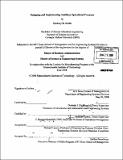| dc.contributor.advisor | Deborah J. Nightingale and Jérémie Gallien. | en_US |
| dc.contributor.author | Smith, Zachary R | en_US |
| dc.contributor.other | Leaders for Manufacturing Program. | en_US |
| dc.date.accessioned | 2009-01-30T16:30:03Z | |
| dc.date.available | 2009-01-30T16:30:03Z | |
| dc.date.copyright | 2008 | en_US |
| dc.date.issued | 2008 | en_US |
| dc.identifier.uri | http://hdl.handle.net/1721.1/44301 | |
| dc.description | Thesis (M.B.A.)--Massachusetts Institute of Technology, Sloan School of Management; and, (S.M.)--Massachusetts Institute of Technology, Engineering Systems Division; in conjunction with the Leaders for Manufacturing Program at MIT, 2008. | en_US |
| dc.description | Includes bibliographical references (p. 83-84). | en_US |
| dc.description.abstract | Amazon.com, one of the largest and most profitable online retailers, has been experiencing such dramatic growth rates that it must continually update and modify its fulfillment process in order to meet customer demand for its products. As the volume of customer orders increases, management at the different fulfillment centers must determine the optimal way to increase the throughput through their facility. Many times the answer lies in improving the primary process, but occasionally it makes better sense if an auxiliary process is built or expanded to meet the increased demand.This thesis analyzes the decision criteria necessary to determine when an auxiliary process should be designed in addition to an established primary process. The author's internship project will be presented as an example of how to implement such a secondary method. The six-month LFM project focused on increasing the Fernley, Nevada fulfillment center's capacity by making improvements to its manual sortation/packaging. This process, nicknamed BIGS, was originally built to offload large and troublesome orders from the primary, automated process path. The unique labor-intensive procedures used in this process held several advantages that justified its existence and the investments necessary to expand its capacity | en_US |
| dc.description.statementofresponsibility | by Zachary R. Smith. | en_US |
| dc.format.extent | 85 p. | en_US |
| dc.language.iso | eng | en_US |
| dc.publisher | Massachusetts Institute of Technology | en_US |
| dc.rights | M.I.T. theses are protected by
copyright. They may be viewed from this source for any purpose, but
reproduction or distribution in any format is prohibited without written
permission. See provided URL for inquiries about permission. | en_US |
| dc.rights.uri | http://dspace.mit.edu/handle/1721.1/7582 | en_US |
| dc.subject | Sloan School of Management. | en_US |
| dc.subject | Engineering Systems Division. | en_US |
| dc.subject | Leaders for Manufacturing Program. | en_US |
| dc.title | Designing and implementing auxiliary operational processes | en_US |
| dc.type | Thesis | en_US |
| dc.description.degree | S.M. | en_US |
| dc.description.degree | M.B.A. | en_US |
| dc.contributor.department | Leaders for Manufacturing Program at MIT | en_US |
| dc.contributor.department | Massachusetts Institute of Technology. Engineering Systems Division | |
| dc.contributor.department | Sloan School of Management | |
| dc.identifier.oclc | 272395664 | en_US |
